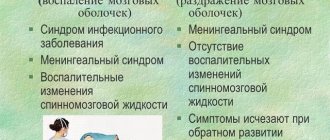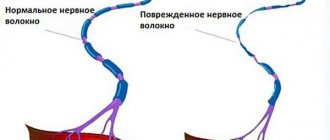More useful information about other various types of diseases starting with the letter “M”: Lesser chorea, Slow infections of the central nervous system, Medulloblastoma, Herniated disc, Thoracic disc herniation, Lumbar disc herniation, Cervical disc herniation, Intercostal neuralgia, Meningeal syndrome, Meningioma, Meningitis , Meningococcal meningitis, Meningomyelitis, Meningoencephalitis, Metabolic myopathy, Metastatic brain tumors, Metachromatic leukodystrophy, Weather sensitivity, Myasthenia gravis, Migraine stroke.
Meningeal syndrome: concept
Meningeal syndrome (MS) is a symptomatic complex that occurs when there are abnormalities in the cerebral surfaces. The presented disease can manifest itself when infectious microorganisms enter the body, intoxication with chemicals, problems with blood vessels, diseases of a liquor-hypertensive nature, damage and anomalies of carcinomatous etiology. The main factors characteristic of MS are the presence of pain in the head, muscle rigidity, gag reflexes, hyperesthesia and algic phenomena.
The basis of the research is clinical indicators and reports after analysis of the spinal substance. The treatment plan is based on the etiology of occurrence. Mostly doctors prescribe medications that have antiviral, antifungal, and antiprotozoal effects. In addition, symptomatic relief and stabilization of intracranial pressure are prescribed.
brief information
Meningeal disorder is a common disease that occurs quite often in the practice of doctors in the field of neurology, pediatrics, otolaryngology and other specializations. Translated from Latin, the name of the pathology means “brain membrane.” There is a type of MS when irritation of the cerebral cavity occurs without inflammatory processes; it is called in medical practice - meningism.
A large number of discoveries, information and rare facts were made back in the 19th century. The disease was studied by many scientists around the world, who eventually offered specific descriptions of the symptoms of the disease. The concepts are currently in use. One of the nuances of a neurological disorder is the inaccurate clinical picture of the disorder in the retirement age population.
Causative agents of meningeal syndrome
Intracranial disorders and multisystem anomalies become harmful causes. Often, MS provokes the progress of the inflammatory process occurring in the brain structures (meningitis), subarachnoid bleeding, and head injury. In accordance with the effect on the cerebral membranes, etiological sources are divided into two categories: inflammatory and non-inflammatory.
First group:
- Bacterial origin: nonspecific (caused by the entry into the body of meningococcal infection, Haemophilus influenzae, pneumococci, and in infants - Escherichia coli and salmonella), specific (begins when pathogenic elements of tuberculosis and syphilis appear in the departments).
- Viral origin - in almost 75% of diagnosed cases, they develop with the participation of enteroviruses, in rare situations - adenovirus, herpetic infection, tick-borne encephalitis, etc. The main factors are microorganisms of cryptococcal, candida, and histoplasmic nature (provoking severe inflammatory foci with petechial hemorrhage).
- Protozoal origin - the main sources are toxoplasmosis and malaria.
Second group:
- A large accumulation of blood cells in the brain structures (appear as a result of an acute malfunction in the circulatory system, severe arterial hypertension, skull injuries, cerebral vasculitis).
- Intracranial hypertension is a consequence of hydrocephalus, neoplasms (formation of a malignant or benign tumor, intracranial cyst, abscess, hematoma).
- Poisoning: exogenous type - paints and varnishes are provocateurs, bad habits such as substance abuse or alcohol addiction, endogenous type - uremia, hypoparathyroidism are considered causative agents.
- Neurotoxic origin in general infections - seasonal influenza, dysentery, colds, etc.
- Carcinomatous origin - complications after infiltration of the cerebral membranes by cancer cells during cancer processes (including the leukocyte type of infiltration in neurolecosis disease).
Development mechanism
In medical practice, there are two types of disease progression: inflammatory and pathogenetic. VP begins when an infection enters the body. Infection of the brain elements occurs in several ways: contact, lymphogenous, perineural and hematogenous. The lesion can be transmitted through blood if the patient has purulent foci. If encephalitis progresses, the harmful anomaly spreads to the soft tissues and causes the development of meningoencephalitis. The pathogenetic mechanism of the flow causes irritation of the cerebral parts. The causative agents are:
- Blood collections during bleeding.
- High surges in intracranial pressure.
- Entry into the body of toxic components (external and formed during dysmetabolic actions).
- Vital activity of negative cells.
- Tissue breakdown during cancer progression.
Symptoms of meningeal syndrome
The symptom complex consists of general cerebral phenomena and meningeal problems. Characteristic clinical manifestations are:
- Diffuse cephalalgia (pain in the head area).
- Vomiting reflexes that are not accompanied by nausea, without making the patient feel better.
- Excited behavior followed by apathetic behavior.
- Seizures.
- The appearance of hallucinations.
- Depression of thinking and consciousness until the patient completely switches off (stupor, coma).
In addition, meningeal syndrome is complemented by pathognomonic symptoms, divided by experts into three main groups:
- Painful phenomena.
- Manifestations of a muscular-tonic nature are an unstable state of muscle tissue.
- Complaints accompanying hyperesthesia - a person develops a high intolerance to noise, light and touch.
Classification of meningeal signs
There are meningeal, cerebral, and general infectious signs, which always accompany pathologies associated with damage to the meningeal tissues of the brain. In the second case we observe:
- Pain in the head area, which often spreads diffusely, is bursting, tense, and painful.
- Nausea, which is usually accompanied by bouts of vomiting. Vomiting can occur spontaneously without a previous feeling of nausea and does not bring relief.
- Confusion, mental and motor agitation, hallucinations. In severe cases of pathology, coma and stupor occur.
- Convulsions of varying intensity and volume - from twitching of single muscles to generalized (distributed throughout the body) convulsive status.
Similar manifestations are characteristic of many CNS pathologies. They arise as a result of swelling of the brain structures, irritation of the meningeal parts of the brain, and disturbances in liquorodynamics. Pain in the head area is a typical meningeal symptom that appears at the onset of the disease and is observed throughout the entire period of its course, until recovery.
In newborns, cephalgic syndrome is often manifested by a characteristic hydrocephalic cry - piercing, sudden, sharp sounds that the baby makes even in an unconscious state, during sleep. Cephalgic syndrome is associated with irritation of nerve endings arising from the trigeminal and vagus nerves, as well as innervating the meninges and blood vessels located in the brain. Vomiting in infants is predominantly gushing in nature. General infectious signs include:
- Malaise, poor health.
- Increased irritability.
- Increased body temperature.
- Heart rhythm disturbances (bradycardia, tachycardia, arrhythmia).
- Hyperemia (redness, flushing) of the skin of the face.
- Rapid breathing.
The variability of individual manifestations should be taken into account. For example, the body temperature with purulent meningitis often exceeds 40°C; with the serous or tuberculous form of meningitis, the temperature is much lower; with the syphilitic form, the temperature remains normal. Direct meningeal symptoms include:
- Hyperesthesia – increased sensitivity to external stimuli.
- Muscle tension of the tonic type, including rigidity (inflexibility, hardness) of the neck muscles, reflexes described by Brudzinsky, Kernig, Lessage (in children).
- Typical reactions in the form of painful sensations when pressing on the area on the face where the trigeminal nerves exit, or on the eyeballs, are pathological reflexes described by Bekhterev, Mendel, Pulatov.
- Changes in neurological reflexes - periosteal (periosteal), tendon, abdominal. Characteristic is the revival of reflexes followed by an uneven decrease in reaction.
A full set of typical symptoms is observed in 7% of patients diagnosed with meningitis initiated by meningococci. In other cases, the manifestations are variable, many meningeal signs may be negative - not appear at all. The severity of manifestations depends on the age of the patient, the type and characteristics of the course of the disease.
Diagnostic options
The patient is accompanied at all stages of examination and further treatment by doctors specializing in problems of infectious origin, a pediatrician, and experts in the field of neurology and therapy. During a visit to the healthcare provider's office, the patient undergoes a standard examination for the presence of characteristic body position, hyperesthesia, pain and tonic phenomena. There are over 30 types of clinical manifestations of complaints that effectively help identify membrane disease. The following are widely used:
- Kernig's sign - the patient assumes a supine position and passively bends his legs.
- Brudzinski's symptoms - in the same position, the doctor palpates the pubis, as a result of which the lower limbs spontaneously pull towards the abdominal cavity.
- Edelman's sign - you need to straighten the big toe when testing using the Kurnig method.
The main role in diagnosing MS is played by lumbar puncture. However, it cannot be done in cases of pronounced hypertension or the likelihood of a mass effect. Such a study can be prescribed only after obtaining information from an ophthalmoscopic analysis and an EEG. Doctors prescribe checking the cerebral substance, blood cells, bacteriological and virological assessment of the cerebrospinal fluid, blood culture, PCR examination and MRI scan of the brain.
Treatment options
The severe stage of MS can only be treated therapeutically in a hospital setting:
- Pharmacological substances of a broad spectrum antibiotic therapy, antiviral and antimycotics are prescribed.
- Detoxification is performed to eliminate the main provocateur.
- Taking diuretics and glucocorticosteroid medications.
- Use of antipyretics, antihypertensive drugs and antiemetic pharmaceuticals.
- Anticonvulsants are prescribed.
Further forecast
If you consult a neurologist or therapist in a timely manner, there is a high probability of a rapid recovery of the patient with MS. Doctors report that residual signs of the disease may appear for several months:
- Chronic fatigue syndrome.
- Emotional instability.
- Headache.
- Increased intracranial pressure.
An unfavorable prognosis can only occur in the case of a course of the disease accompanied by serious pathology of the central nervous system, ultra-rapid development of infectious lesions and oncology.
Preventive actions
To prevent the occurrence of meningeal syndrome, you should adhere to the following rules:
- Monitor the level of your immune system.
- During the prevention of infectious diseases.
- Avoid injury and poisoning.
- Promptly contact a specialist in case of cerebrovascular anomalies and cardiovascular diseases.
Specific preventive actions may be relevant for infectious microorganisms that cause meningococcus and pneumococcus.
Checking for meningeal symptoms
To check meningeal symptoms, methods are used that reflect the state of muscle tone, the severity and adequacy of reflexes, mainly tendon and muscle. In neurology, typical meningeal symptoms in adults are distinguished:
- Brudzinsky upper. Tested in a position lying on your back. When trying to tilt the head towards the chest, the lower limbs involuntarily bend in the area of the hip and knee joints.
- Brudzinski average. Tested in a position lying on your back. Pressing the pubic bone area causes unconscious flexion of the legs at the hip and knee joints.
- Brudzinsky lower. Tested in a position lying on your back. An attempt to passively straighten a leg bent at the joints of the hip and knee; the second lower limb spontaneously bends at the same joints.
- Kernig. A patient who is in a supine position with his legs bent at the hip and knee joints (90°) is unable to straighten his lower limbs at the knees to 180° due to severe pain. The condition is caused by rigidity (stiffness, hardness) of the muscles in the back and limbs.
- Fanconi. Tested in a position lying on your back. The patient's lower limbs are extended at the knee joints and fixed in this position. Being in this position, the patient cannot sit up without assistance.
- Amossa. Tested in position while sitting on the bed. The patient is in a sitting position, leaning on both upper limbs, losing balance and falling without support on his arms.
- Guillain. Tested in a position lying on your back. Compression of the quadriceps muscle located in the hip area causes the other lower limb to involuntarily bend at the hip and knee joints.
The patient experiences pain when trying to lower his head towards the chest. Such difficulties arise due to increased tension in the neck extensor muscles. The typical meningeal position, known as the pointing dog position, involves the patient lying on his side with the head tilted strongly back, legs bent at the knees and drawn towards the abdomen. The posture is associated with rigidity of the long dorsal muscles. Painful phenomena are considered characteristic meningeal signs in adults:
- Bekhterev's reaction. Percussion (light blows) on the zygomatic arch area provokes (intensifies) pain in the head area. The condition occurs due to contraction of the facial muscles.
- Lobzin's reaction. Painful sensations arise as a result of manual pressure on the eyeballs with the eyelids closed.
- Mandonesi's reaction. Pressure on the area of the eyeballs (eyelids are closed) leads to a tonic contraction of the facial muscles.
The Bickel reaction is based on passive extension of the patient's arms, which are bent at the elbows. The therapist encounters unconscious resistance when performing the movement. The study of meningeal symptoms is performed by a neurologist. To make a final diagnosis, special diagnostic algorithms are used.








